Digitale Spiegel: Technologie, Funktionen und Anwendungen
September 19, 2025
Das Inhaltsverzeichnis:
- Was ist ein digitaler Spiegel?
- Funktionen, Benutzererfahrung und Leistung, die digitale Spiegel auszeichnen
- Installation, Sicherheit und technische Infrastruktur von digitalen Spiegeln
- Wie Integration und Konnektivität digitale Spiegel ermöglichen
- Digitale Spiegel Anwendungen und Anwendungsfälle in der Industrie
- Was beeinflusst die Kosten für digitale Spiegel?
- Wartung, Lebenszyklus und Compliance – Grundlagen digitaler Spiegel
- Fazit
- FAQ
Ein digitaler Spiegel ist die Verbindung von Reflexion und Intelligenz – eine nahtlose Kombination aus Spiegelglas und integriertem Display, die eine gewöhnliche Oberfläche in ein interaktives Erlebnis verwandelt. Er vereint Design und digitale Leistung und ermöglicht es Benutzern, das Wetter zu überprüfen, die Beleuchtung zu steuern oder persönliche Daten einzusehen, ohne dabei auf eine elegante Ästhetik verzichten zu müssen. Diese Verschmelzung von Funktion und Form definiert Badezimmer, Hotelzimmer und Einzelhandelsumgebungen weltweit neu.
Was ist ein digitaler Spiegel?
Ein digitaler Spiegel vereint hochtransparentes Glas mit einem integrierten digitalen Display, einem Prozessor und Sensoren. Er zeigt Informationen über die Spiegeloberfläche an und bewahrt dabei ein klares Spiegelbild, wodurch eine multifunktionale und optisch raffinierte Schnittstelle entsteht.
Moderne Smart-Digitalspiegel verwenden OLED- oder LCD-Panels, die hinter dielektrischem Spiegelglas angebracht sind und so Reflexion und Bildschärfe ausgleichen. Die Interaktion erfolgt über Berührung, Sprachsteuerung oder Gestenerkennung, unterstützt durch KI-basierte Sensoren.
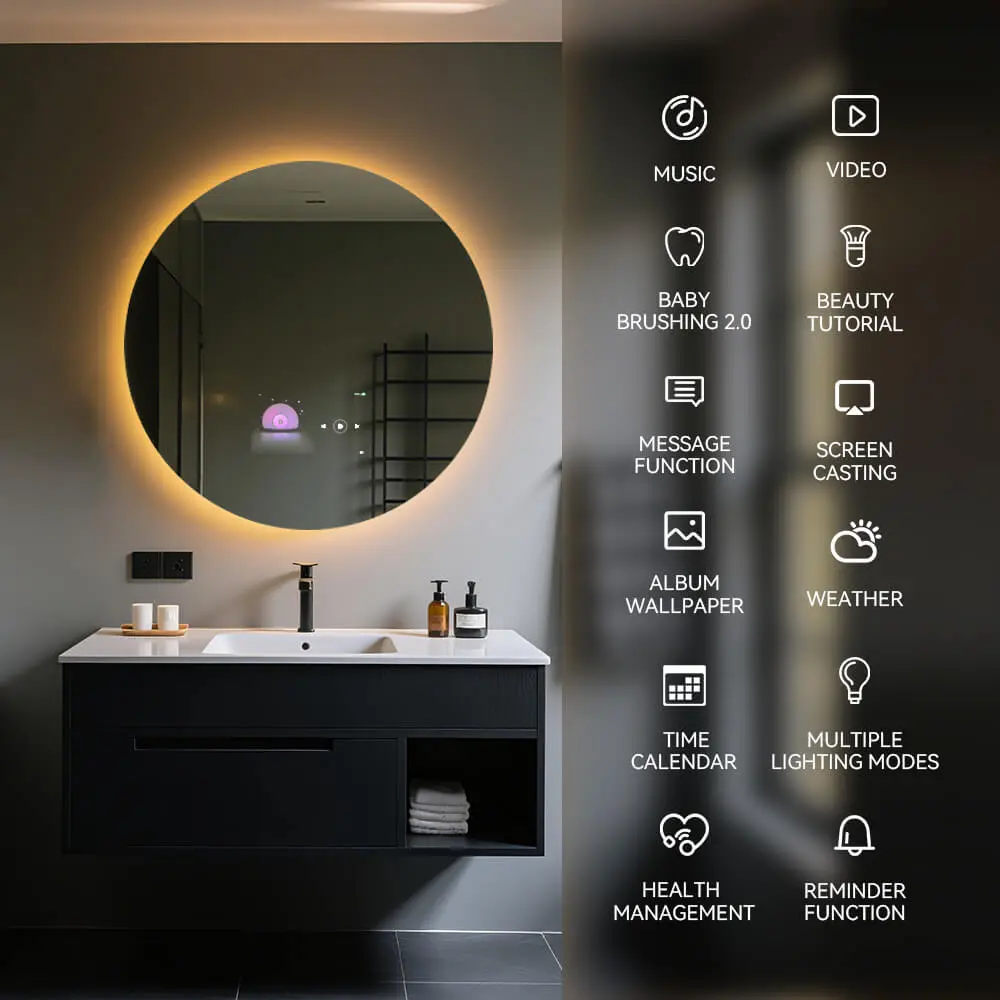
Wi-Fi-, Bluetooth- oder Ethernet-Konnektivität verbindet Spiegel mit umfassenderen Ökosystemen – von Hotelmanagementsystemen bis hin zu Hausautomatisierungsplattformen. Im Wesentlichen ist ein digitaler Spiegel sowohl ein Designobjekt als auch eine Drehscheibe für digitale Intelligenz.
Digitaler Spiegel vs. Smart-TV vs. LED-Spiegel:
| Funktion | Digitaler Spiegel | Smart-TV (hinter Glas) | LED-Spiegel |
| Reflektivität | Hoch | Niedrig | Hoch |
| Interaktivität | Berührung, Stimme, Geste | Begrenzt | Keine |
| Anwendungsfall | Badezimmer, Einzelhandel, Gastgewerbe | Wohnzimmer | Schminkspiegelleuchte |
| Energie-Effizienz | Optimiert | Mäßig | Hoch |
Diese doppelte Funktionalität verwandelt Spiegel von statischen Dekorationselementen in dynamische, vernetzte Oberflächen.
Funktionen, Benutzererfahrung und Leistung, die digitale Spiegel auszeichnen
Ein digitaler Spiegel vereint Innovation und Handwerkskunst, um ein beeindruckendes Benutzererlebnis zu bieten. Sein Wert wird durch drei zentrale Funktionen definiert: Interaktivität, optische Technik und Personalisierung.
- Intelligente Interaktivität. Benutzer können die Schnittstelle per Touch, Sprache oder Geste steuern. Die Integration mit Alexa oder Google Home ermöglicht eine freihändige Bedienung – ein großer Vorteil im Gastgewerbe und im Wellnessbereich.
- Präzise Beleuchtung. Ein digitaler Badezimmerspiegel verwendet LED-Licht mit hohem CRI (90+) und Antibeschlagsysteme, um auch in dampfigen Umgebungen Farbgenauigkeit und visuelle Klarheit zu gewährleisten. Die einstellbare Helligkeit passt sich an die Morgenroutine oder das Abendambiente an. Nach dem technischen Ansatz von MUES-TEC wird jedes Beleuchtungssystem so kalibriert, dass es echtes Tageslicht nachbildet und Präzision für die Körperpflege, Hautpflege und Gastgewerbestandards gewährleistet. Die optischen Beschichtungen des Unternehmens minimieren die Blendung und bewahren gleichzeitig die perfekte Spiegelbalance.
- Personalisierung und Datenschutz. Die Profilerkennung ermöglicht eine individuelle Beleuchtung oder Gestaltung der Benutzeroberfläche. Hardware-Kameraverschlüsse bieten zusätzlichen physischen Datenschutz – eine wachsende Anforderung, die durch Forbes Technology Council.
Wichtige Leistungsparameter:
- Reflexionsausgleich für optimale Klarheit.
- Eingabelatenz unter 50 ms für nahtlose Interaktion.
- Leistungsoptimierung für langfristige Effizienz.
Im Wesentlichen verwandeln digitale Spiegel persönliche Routinen in vernetzte Erlebnisse – wobei Technologie für mehr Klarheit, Komfort und Individualität sorgt.
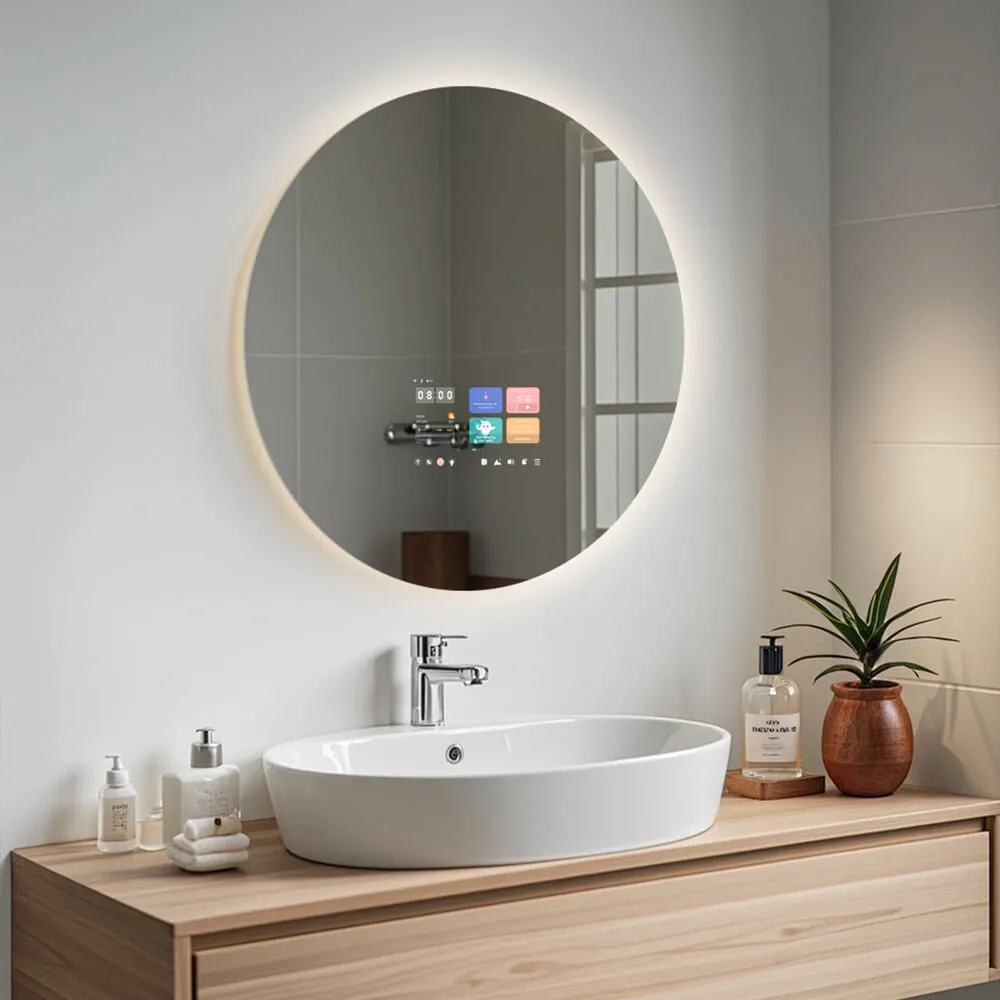
Installation, Sicherheit und technische Infrastruktur digitaler Spiegel
Die Installation eines smarten digitalen Spiegels erfordert eine präzise Planung und die Einhaltung technischer Standards. Eine ordnungsgemäße Vorbereitung gewährleistet Sicherheit, Langlebigkeit und eine nahtlose visuelle Integration.
- Befestigungslösungen. Aufputzmontagen eignen sich für Renovierungen, während Einbaumontagen für architektonische Konstruktionen geeignet sind. Die Einbautiefe und die Belüftungsanforderungen variieren je nach Displaygröße.
- Stromversorgung und thermische Sicherheit. In feuchten Umgebungen sind spezielle, durch FI-Schutzschalter gesicherte Stromleitungen vorgeschrieben. Ein ausreichender Luftstrom hinter dem Gerät ist unerlässlich, um thermische Belastungen zu vermeiden.
- Wasserschutz und Einhaltung der Vorschriften. Bei einem digitalen Spiegelbad sorgt eine Zertifizierung wie IP44 oder IP65 für Feuchtigkeits- und Kondensationsbeständigkeit. Elektrische Anschlüsse müssen den Normen IEC 60364 für Badezimmerbereiche entsprechen.
Checkliste für Installateure:
- Überprüfen Sie die Tragfähigkeit der Wand.
- Hinter dem Gerät einen Freiraum von 10 mm für die Belüftung lassen.
- Verwenden Sie wasserdichte Steckverbinder und IP-zertifizierte Stromkabel.
- Halten Sie einen Sicherheitsabstand zu Wasserauslässen ein.
Zusammenfassend lässt sich sagen, dass die Installation die Grundlage für Zuverlässigkeit ist. Ein gut installierter digitaler Spiegel funktioniert jahrelang sicher und elegant und wird so zu einem nahtlosen Bestandteil der Architektur statt zu einem eigenständigen Gerät.
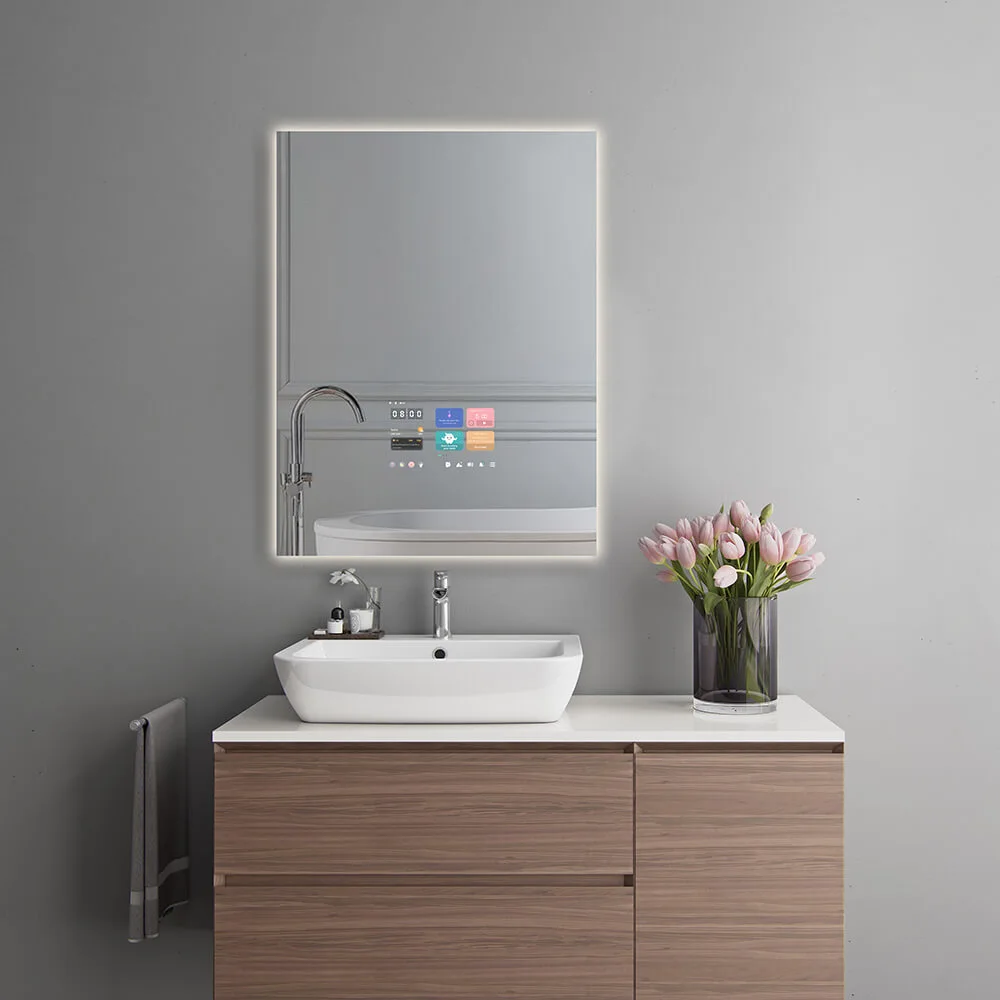
Wie Integration und Konnektivität digitale Spiegel ermöglichen
Digitale Spiegel fungieren als intelligente Kontrollzentren innerhalb vernetzter Räume – nicht als isolierte Geräte, sondern als integrierte digitale Knotenpunkte.
- Smarte Betriebssysteme. Die meisten Spiegel laufen unter Android oder Linux, mit OTA-Updates und zentralisierter MDM/EMM-Verwaltung für vernetzte Flotten in Hotels oder Fitnessstudios.
- Software- und Systemintegration. Mithilfe offener APIs kommunizieren Spiegel mit PMS-, POS- oder Gebäudemanagementsystemen (BMS) und unterstützen so die Datensynchronisation und personalisierte Erlebnisse.
- Smart-Home-Kompatibilität. Die Integration mit Alexa, Google Home und Apple HomeKit ermöglicht die Steuerung der Beleuchtung, die Medienwiedergabe oder die Umgebungsüberwachung – entsprechend der von prognostizierten Smart-Home-Akzeptanzrate von 25 %. Statista.
- Analysen und Erkenntnisse. Spiegel-Dashboards liefern Engagement-Statistiken, Nutzungs-Heatmaps und Daten zum Gerätezustand – unverzichtbar für die Optimierung der geschäftlichen Performance.
Durch die Integration wird ein digitaler Spiegel zu einer lebendigen Schnittstelle – reaktionsschnell, vernetzt und perfekt auf die smarten Umgebungen abgestimmt, in denen er zum Einsatz kommt.
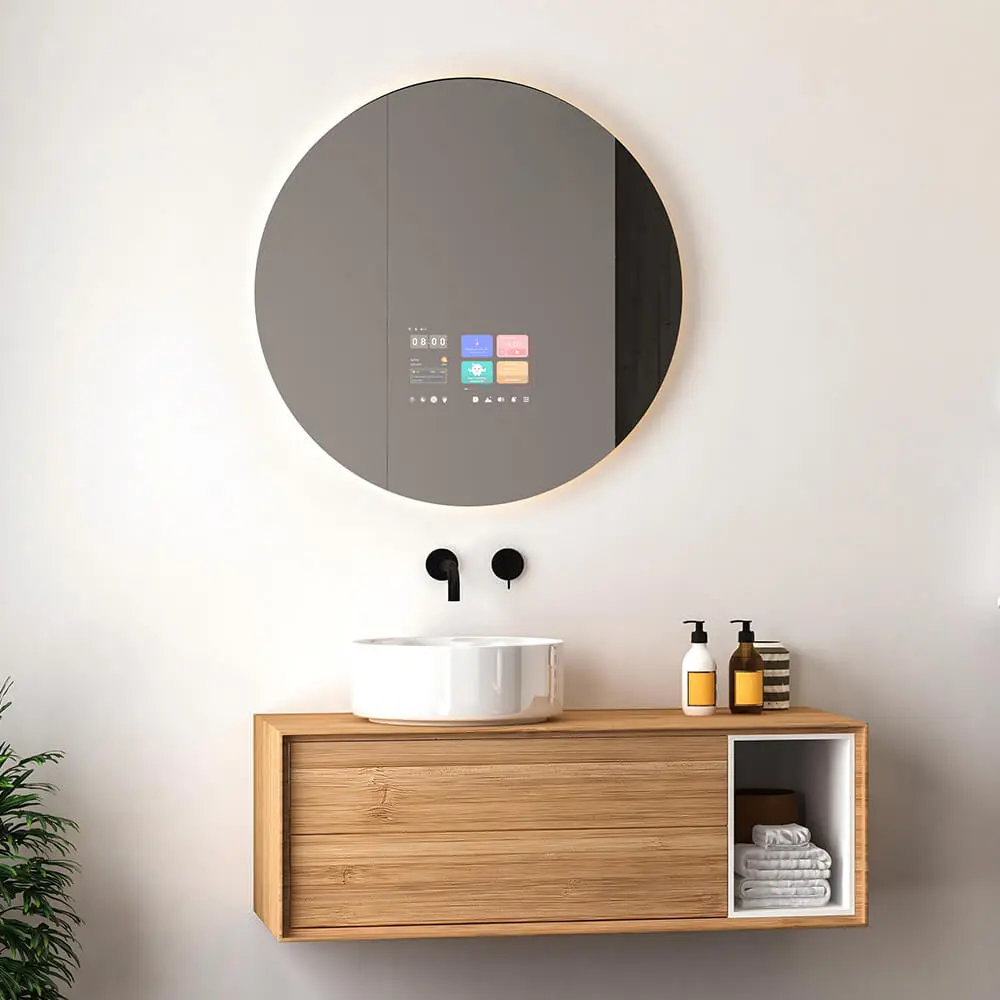
Digitale Spiegel Anwendungen und Anwendungsfälle in der Industrie
Die Flexibilität digitaler Spiegel ermöglicht einen breiten Einsatz in verschiedenen Branchen und verbindet Ästhetik und Innovation, um das tägliche Leben zu verbessern.
Hospitality: Das Gästeerlebnis verbessern
Hotels und Resorts setzen digitale Spiegel in Gästesuiten, Spas und Lobbys ein, um Informationen, Beleuchtung und Unterhaltung bereitzustellen. Laut Hotel Tech Report ersetzen Spiegel unübersichtliche Wandbildschirme, verbessern die Innenausstattung und steigern gleichzeitig die Zufriedenheit der Gäste.
Hotelketten haben MUES-TEC Smart Mirrors für ihre Gästeerlebnisprogramme eingeführt und dabei Raumsteuerungsschnittstellen, Wellness-Widgets und Markeninhalte direkt in die Spiegeloberfläche integriert.
Einzelhandel & Mode: Die erweiterte Umkleidekabine
Im Einzelhandel ermöglicht ein smarter digitaler Spiegel virtuelle Anproben und Styling-Empfehlungen. Vernetzte Inventarsysteme und KI-Visualisierungstools steigern die Kundenbindung, was zu längeren Verweildauern und höheren Konversionsraten führt.
Wohnen & Wellness: Individuell gestaltete Tagesabläufe
In Privathaushalten bieten digitale Badezimmerspiegel Komfort – sie steuern Beleuchtung, Nachrichten und Gesundheitsdaten an einem Ort. Fitnessvarianten verwenden integrierte Kameras und KI, um Form und Fortschritte zu verfolgen und bieten professionelle Anleitung zu Hause.
Gesundheitswesen und Unternehmen: Von Kliniken bis zu Vorstandsetagen
Telemedizin-Spiegel zeigen Gesundheitsdaten in Echtzeit an und unterstützen virtuelle Konsultationen. In Büros zeigen interaktive Lobby-Spiegel Termine, Nachhaltigkeitskennzahlen oder Markenbilder an und verbinden so Form und Funktion.
Vielseitigkeit im Design:
- Rahmenlose oder maßgeschneiderte Einfassungen.
- Selektive Reflektivitätsbeschichtungen und Oberflächenoptionen.
- Integration mit Umgebungsbeleuchtung und Soundsystemen.
- Individuelles UI-Branding für Hotels oder Einzelhandelsketten.
Letztendlich liegt die Schönheit digitaler Spiegel in ihrer Universalität – sie passen sich jedem Raum und Zweck an und steigern sowohl den Designwert als auch die Nutzerinteraktion.
Was beeinflusst die Kosten für digitale Spiegel?
Die Kosten für einen digitalen Spiegel variieren und hängen eher von Design, Funktion und Integrationsgrad als vom einfachen Stückpreis ab.
Zu den primären Kostenfaktoren gehören:
- Displaytyp und -größe. OLED- und hochauflösende Modelle bieten eine hervorragende Bildqualität, erfordern jedoch eine fortschrittliche Fertigung.
Funktionalität. Die Integration mit IoT, Sprachsteuerung oder Analysen erhöht die Komplexität des Systems.
Materialqualität. Hochwertige Beschichtungen, Einfassungen und strapazierfähiges Glas steigern den Produktionswert.
Installationsumgebung. Spiegel für Badezimmer und Außenbereiche erfordern einen höheren IP-Schutz und eine spezielle Abdichtung.
Software und Support. Cloud-CMS-Plattformen, OTA-Updates und Überwachung sorgen für mehr Skalierbarkeit der Dienste.
Investitionen in smarte digitale Spiegel bieten einen dauerhaften Mehrwert – sie verwandeln Gebrauchsgegenstände in Luxusartikel und Design in Interaktion.
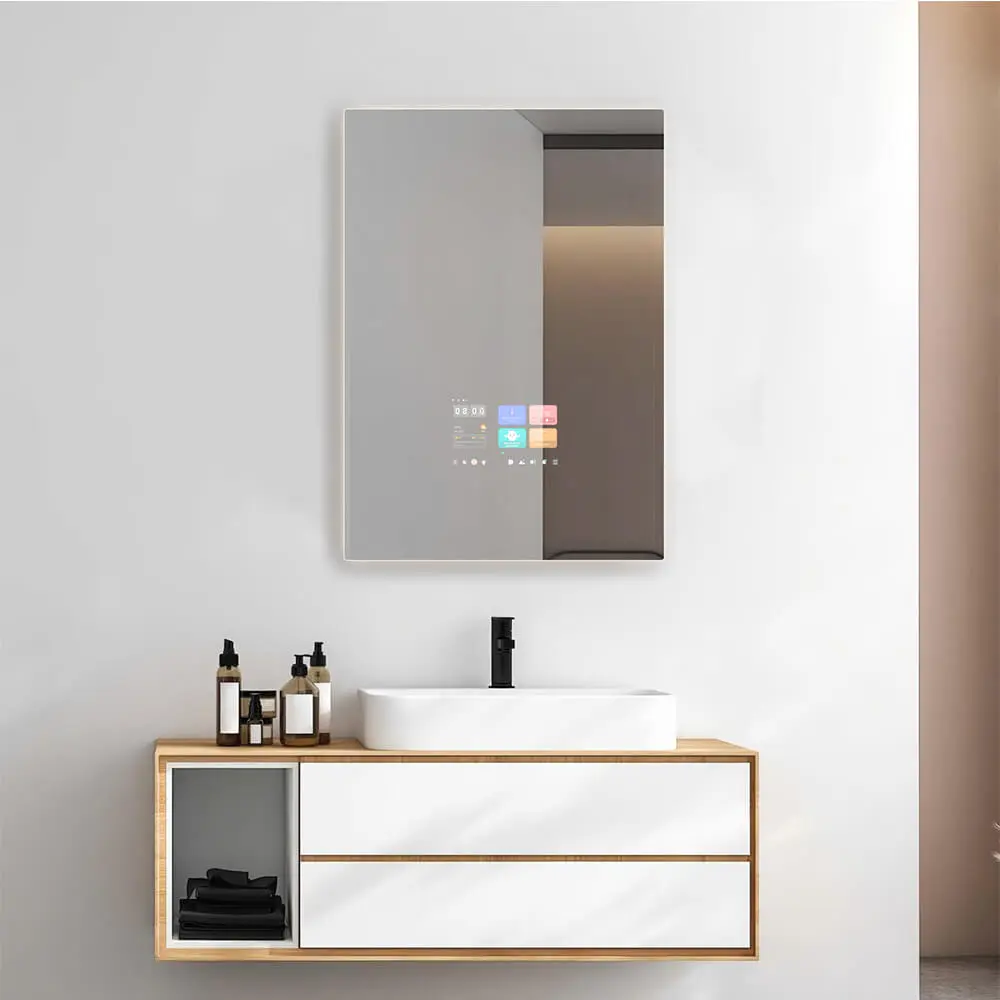
Wartung, Lebenszyklus und Compliance – Grundlagen digitaler Spiegel
Um eine langfristige Zuverlässigkeit zu gewährleisten, erfordern digitale Spiegel eine regelmäßige Pflege und die Einhaltung globaler Standards.
- Reinigung und Pflege. Verwenden Sie pH-neutrale Reinigungsmittel und Mikrofasertücher; vermeiden Sie alkoholhaltige Sprays, die die Antibeschlagschicht angreifen. Durch regelmäßige Reinigung bleiben die Reflektivität und die optische Qualität erhalten.
Softwarewartung. Führen Sie regelmäßig OTA-Firmware-Updates durch, um die Sicherheit und Leistung zu verbessern. Die Agentur der Europäischen Union für Cybersicherheit (ENISA) empfiehlt häufige Patches für alle verbundenen IoT-Geräte.
Lebenszyklus und Nachhaltigkeit. Hochwertige Displays haben in der Regel eine Lebensdauer von mehr als 50.000 Stunden. Das modulare Design ermöglicht den Austausch von Teilen und das Recycling gemäß den EU-WEEE-Richtlinien.
Zusammenfassend lässt sich sagen, dass Wartung der Schlüssel zu Langlebigkeit und Vertrauen ist. Bei richtiger Pflege bleibt ein digitaler Spiegel eine dauerhafte Verbindung von Innovation und Ästhetik – zuverlässig, nachhaltig und zukunftsfähig.
Fazit
Digitale Spiegel sind mehr als nur reflektierende Geräte – sie sind die Verkörperung von interaktivem Design und technischer Präzision. Durch die Kombination von ästhetischem Minimalismus mit funktionaler Intelligenz definieren sie die Art und Weise neu, wie Menschen Innenräume erleben.
Von Hospitality-Suiten bis hin zu Wohnräumen symbolisieren intelligente digitale Spiegel einen Wandel hin zu einem integrierten Lebensstil, in dem Design, Information und Innovation nahtlos miteinander verschmelzen. MUES-TEC gestaltet die Zukunft der Reflexion weiterhin mit deutscher Technologie, intuitivem Design und kompromissloser Qualität.
FAQ
Wozu wird ein digitaler Spiegel verwendet?
Ein digitaler Spiegel fungiert sowohl als reflektierende Oberfläche als auch als digitale Schnittstelle, die in Privathaushalten, Hotels, Spas und Einzelhandelsgeschäften zur Anzeige von Informationen und zur Steuerung vernetzter Systeme eingesetzt wird.
Wie funktionieren digitale Spiegel in feuchten Badezimmern?
Ein digitaler Badezimmerspiegel verfügt über versiegelte Gehäuse, Heizfolien und Antibeschlagbeschichtungen, die Feuchtigkeitskondensation verhindern und die Bildqualität erhalten.
Sind smarte digitale Spiegel energieeffizient?
Ja. Die meisten smarten digitalen Spiegel nutzen Auto-Sleep-Sensoren, effiziente LED-Beleuchtung und optimierte Prozessoren, wodurch sie deutlich weniger Strom verbrauchen als herkömmliche Displays.
Wie wird der Datenschutz gewährleistet?
Diese Spiegel verwenden verschlüsselte Kommunikation, lokale Datenverarbeitung und optionale Kameraverschlüsse, um die DSGVO-konforme Privatsphäre zu gewährleisten.
Welche Wartungsarbeiten sind erforderlich?
Routinemäßige Reinigung, Firmware-Updates und regelmäßige Inspektion der Dichtungen oder Lüftungssysteme reichen für eine stabile Leistung aus.
Können digitale Spiegel in Automatisierungssysteme integriert werden?
Ja. Sie lassen sich mit Smart-Home- oder BMS-Plattformen für die Steuerung von Beleuchtung, Klima und Unterhaltung verbinden.
Welche Branchen profitieren am meisten?
Die Bereiche Gastgewerbe, Einzelhandel, Fitness, Gesundheitswesen und Immobilien nutzen digitale Spiegel, um das Nutzererlebnis und die betriebliche Effizienz zu verbessern.
Neueste Artikel
September 26, 2025
Touchscreen Mirror Applications: From Bathrooms to Retail SpacesSeptember 19, 2025
Digitale Spiegel: Technologie, Funktionen und AnwendungenSeptember 8, 2025
Smart Mirror Link Integration: Connecting Apps and Devices